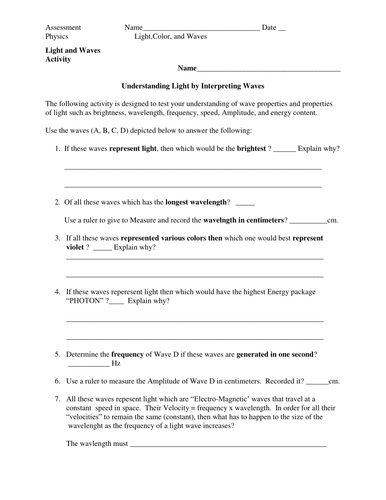

This activity is geared toward mid to upper Middle School and High School students were properties of waves and light are covered. It can be used as an introduction to the subject of wave properties or a formative assessment that tests a student’s understanding of wavelength, amplitude, frequency and wave velocity. It connects wave properties to light properties such as brightness, energy, and color. The activity allows students to investigate the various relationships such as energy versus frequency, color versus frequency, wavelength versus frequency, brightness and amplitude. Students are asked to answer a series of queries on a series of waves and take several measurements of Amplitude and Wavelength.
This activity uses samples of various waves to promote a Constructivist approach were learners are actively engaged in a process of meaning-making and knowledge construction. The activity was well field tested in Physical Science classes and High School Science classes of varying levels with great success. Analysis questions are designed to allow students to be active learners and using academic language in carving their responses. The activity contains both inquiry based questions and samples of waves. There is an Analysis Section containing an answer key and some suggested online resources for teachers.
The following NGSS are supported by this activity: 4-PS4-1. Develop a model of waves to describe patterns in terms of amplitude and wavelength and that waves can cause objects to move. [Clarification Statement: Examples of models could include diagrams, analogies, and physical models using wire to illustrate wavelength and amplitude of waves. MS-PS4-1 Use mathematical representations to describe Using Mathematics and Computational Thinking Mathematical and computational thinking at the 6–8 level builds on K–5 and progresses to identifying patterns in large data sets and using mathematical concepts to support explanations and arguments. Use mathematical representations to describe and/or support scientific conclusions and design solutions. Use a simple model for waves that includes how the amplitude of a wave is related to the energy in a wave.
This activity uses samples of various waves to promote a Constructivist approach were learners are actively engaged in a process of meaning-making and knowledge construction. The activity was well field tested in Physical Science classes and High School Science classes of varying levels with great success. Analysis questions are designed to allow students to be active learners and using academic language in carving their responses. The activity contains both inquiry based questions and samples of waves. There is an Analysis Section containing an answer key and some suggested online resources for teachers.
The following NGSS are supported by this activity: 4-PS4-1. Develop a model of waves to describe patterns in terms of amplitude and wavelength and that waves can cause objects to move. [Clarification Statement: Examples of models could include diagrams, analogies, and physical models using wire to illustrate wavelength and amplitude of waves. MS-PS4-1 Use mathematical representations to describe Using Mathematics and Computational Thinking Mathematical and computational thinking at the 6–8 level builds on K–5 and progresses to identifying patterns in large data sets and using mathematical concepts to support explanations and arguments. Use mathematical representations to describe and/or support scientific conclusions and design solutions. Use a simple model for waves that includes how the amplitude of a wave is related to the energy in a wave.
Something went wrong, please try again later.
This resource hasn't been reviewed yet
To ensure quality for our reviews, only customers who have downloaded this resource can review it
Report this resourceto let us know if it violates our terms and conditions.
Our customer service team will review your report and will be in touch.
$0.00